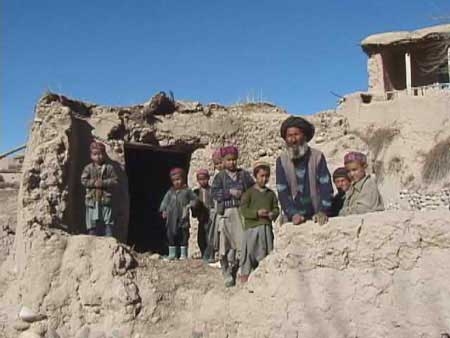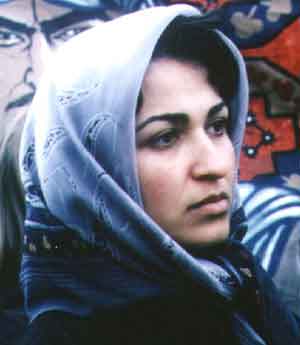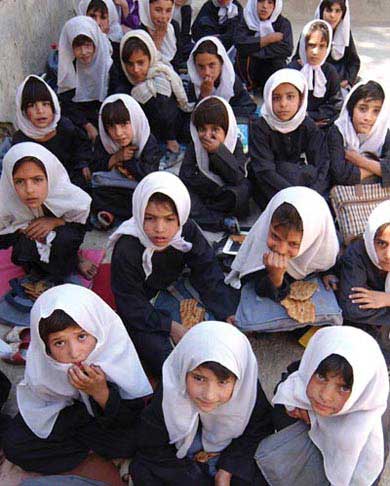Benard tells of her first impressions of Afghan society in Pakistan refugee camps
“men, boys, and dust”

Chpt. 1
Benard tells of her first impressions
of Afghan society in Pakistan refugee camps
“men, boys, and dust”

horrifying rates of maternal and infant mortality, staggering rates of domestic violence, women dying because they were not taken for medical attention
told not to interfere; “it’s
their culture”
asks: aren’t women part of the
national
“they”? don’t they have opinions?
in response, she’s given a lot of pat answers such as, “they don’t question their lot,” or “they feel safe within the family,” or “they don’t know any other way”
Benard was transformed by her visit to a women’s hospital; their stories.
14-year old girl in a catatonic state after being married of to a man in his seventies; he beat her for resisting his sexual advances, then returned her to her family when this didn’t work; they turned her over to a mullah who tried to “exorcise the demon” causing her to resist; when this didn’t work, the family brought her to be treated for insanity. In the end, the hospital will prescribe her tranquilizers to prevent her further resistance.
In another bed, a healthy woman and her newborn who’s husband and family refused to bring them back home because the baby was a girl. They were frightening her into thinking she was abandoned so that she’d “try harder” next time to have a boy.
In another bed, a young woman worn out, emaciated after her 6th or 7th miscarriage in a short spate of time. The doctor tried to explain to her husband that her body needed time to recuperate, to no avail. He said, “It is the woman’s job, intended by God, to give children. If she dies, that is God’s will and I will marry another woman.”
Another woman had lost her mind when her eight-year old son was taken away to be a “freedom fighter”
Others had been deprived of light and air and movement so long that their skin and muscles were damaged.
Still others, widows or rejected by husbands with no where else to go.
“These are the lucky ones.” The doctor says. “The ones whose families allow medical treatment. Have you hear the Afghan saying: a woman should only leave her house twice: once at her wedding, to go to her husband, and once when she dies, to be taken to the graveyard.
While at the hospital, a woman whispers in her ear that there is a school for girls, organized by RAWA.
Chpt. 2 The Petal and
the Rock: Meena

Meena: legendary founder of the Revolutionary Association of the Women of Afghanistan
Born in 1957
Studied at the Shariat
University in Kabul
At 19 she married a leftist organizer who supported
her political activism
Founded RAWA to be “a
genuinely democratic
movement” committed to non-violence; an independent women’s
organization.
Meena as RAWA’s martyr; a charismatic, energetic, humble and brave heroine whose spirit is remembered by all who met her.
RAWA began in the early
‘70s
as in West, college
campuses were roiling with youth anxious to change their societies and
the world
1970s a time of freedom and
contact with
the world for Afghanistanis.
People traveled; women were sent to
Turkey to study to be nurses;
Western movies played in big cities.
Afghanistan still a monarchy
then.
Somewhat sympathetic to calls for modernization, greater freedom
and literacy for women, but like the ruling elites of many developing
countries
they “preferred the spas of Europe to the depressing conditions at
home.”
1979
Soviet invasion
15
years of Communist regime, Soviet occupation.
Then, more civil war as US supported “freedom
fighters” mujahadin drive out the Soviets.
Eventually, the Taliban win over the Northern Alliance and establish a totalitarian regime that exerts an unprecedented level of repression against women.
During the Soviet occupation, Meena and most of RAWA forced into refugee camps in Pakistan.
Strategy and make-up:
As in S. America, Israel, the Balkans,
the Soviet Union, women used their commitment to non-violence and their
moral authority as mothers to chastise soldiers, power mongers (21).
Goals:
to be a force for democratic,
non-violent change; to be an independent organized force to rebuild
Afghan
CIVIL SOCIETY; to support Afghani women in any way they need; to be an
example of what is possible for women - living as if.
Organization:
fairly informal, ad hoc.
No sense having rules about quorums and such since it is very difficult
for women to get out (under the Taliban especially) to make it to
meetings.
So whoever is present participates.
Has some 2,000 formal members
who PLEDGE NOT TO EMIGRATE but also a diffuse network of supporters,
both
women and men, who make their activities possible in small but
important
ways: serving as lookouts, safe houses, informing the women if
police
are lurking nearby, men serving as mahram, i.e., escorts for the women
when they go on their missions.
Tactics/activities:
non-violent
protest/demonstrations;
a conscious decision to be active in politics;
distribution of leaflets;
publication and distribution of the periodical
Payam-e-Zan;
educating girls, women first but also boys and men;
organizing
secret schools in homes and more organized ones as well;
creating opportunities
for consciousness raising, independent thought. e.g, one they do this
is
through personal correspondence with people who come across their
magazine
and write to them.
Aid and support to women who need it.
Personal
attention, social services;
work against violence
Fundraising:
self-generating income - grassroots
efforts, make and sell things like carpets, raise chickens, sewing
little
mirrors onto ornamental cushions. As news of RAWA’s activities
spread
to the West, it began to receive occassional funding from Western
sponsors
as well as contributions in-kind, e.g., long underwear from Austrian
grandmas.
From a RAWA brochure:
To the
Fundamentalists:
You can dim the light
of the candles whose
glow warms my eyes
You can freeze the
kisses on my lips
You can fill the air
with curses
Or with the terrible
silence of my grief
You can steal my
sister’s smile
You can put up a
thousand walls
You can do all that
And I, I can fight.
Benard on RAWA
Benard asserts that RAWA is the first group
of women willing to risk their lives for women’s rights. Is this true?
Perhaps, but that’s not to say women haven’t risked their lives for many causes not to mention the women who risk their lives every day by staying in violent relationships to protect people they love, sell their bodies to feed them, etc..
She speaks rather dismissivel of women’s political activism in the West, of women chaining themselves to the gates of Parliament to get the vote.
Is this fair? What about all the women who risked their lives hiding Jews from the Nazis or helping slaves escape?
True that we just don’t know as much about the heroic actions of women because they are overshadowed in the history books by the men.
Chpt 4 and
Gives profiles of a few
RAWA members and a few male supporters
What kinds of experiences drew women into RAWA?
Chpt 7
Gives some profiles of men who
support RAWA
Why do they support it?
What surprised you about
their stories,
their beliefs and opinions?
More Recent Developments
Although initially ignored, women did
participate in the loya jirga to draft the new Afghan constitution

The new constitution (adcopted
January 4, 2005)
guarantees all Afghans right to vote at 18
Article 44
[Education for Women and Nomads, Illiteracy]
The state shall devise and implement effective programs for balancing
and promoting of education for women, improving of education of nomads
and elimination of illiteracy in the country.
Article 53
[Handicapped]
(1) The state takes necessary measures for regulating medical services
and financial support to descendants of those who were martyred or are
missing, to disabled or handicapped, and their active participation and
re-integration into society in accordance with the law.
(2) The state guarantees the rights and privileges of pensioners and
disabled and handicapped individuals and as well renders necessary
assistance to needy elders, women without caretakers, and needy orphans
in accordance with the law.
Article 54
[Family]
(1) Family is a fundamental unit of society and is supported by the
state.
(2) The state adopts necessary measures to ensure physical and
psychological well being of family, especially of child and mother,
upbringing of children and the elimination of traditions contrary to
the principles of sacred religion of Islam.
Article 84 [Senate]
(1) Members of the Senate [Meshrano Jirga] are elected and
appointed as follows:
(2) From among the members of each provincial council, the respective
council elects one person for a period of four years.
(3) From among the district councils of each province, the respective
councils elect one person for a period of three years.
(4) The President from among experts and experienced personalities --
including two representatives from the disabled and impaired and two
representatives from the Kochis -- appoints the remaining one-third of
the members for a period of five years.
(5) The president appoints 50% of these people from among women.
Women will now hold at least 64 out of 250 seats in the lower
house of the Afghan parliament, more than 25 percent, which is higher
than in most Western
democracies.
There is an Afghan Ministry
for Women's Affairs headed by a woman
In March 2005, a woman was
appointed to be governor of an Afghan state for the first time
There is a new government
campaign to encourage girls to be enrolled in school

There is a new law
making it illegal to force girls into marriage